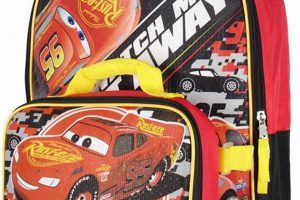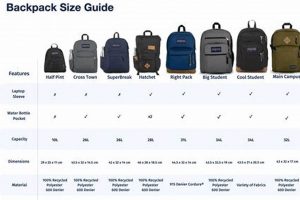The structural component of a pack designed for hunters, this element provides support and load distribution. Often constructed from metal or composite materials, it interfaces with the pack bag and harness system. For example, an external type may feature an exposed structure, while an internal type is integrated within the pack’s construction.
This foundational part is crucial for carrying substantial weight comfortably over extended periods in the field. Its design impacts weight transfer to the hips and legs, minimizing strain on the shoulders and back. Historically, simpler versions were used, but modern iterations incorporate advanced ergonomics and materials to enhance efficiency and comfort.
Understanding the different types of these support systems, the materials used in their construction, and their impact on load management is essential for selecting the appropriate pack for specific hunting needs. The following sections will delve into these aspects, providing a detailed examination of this important piece of equipment.
Tips for Selecting a Hunting Backpack Frame
Selecting the appropriate load-bearing structure for a hunting pack is crucial for a successful and comfortable experience in the field. Prioritize factors like load capacity, frame material, adjustability, and compatibility with the intended hunting style.
Tip 1: Assess Load Requirements: Evaluate the typical weight and volume of gear to be carried. Consider factors such as the duration of the hunt, game size, and necessary survival equipment. A larger load necessitates a more robust and supportive structure.
Tip 2: Consider Frame Material: Frame materials vary in weight, strength, and flexibility. Aluminum alloys offer a balance of strength and weight, while carbon fiber provides superior weight savings but at a higher cost. Polymer materials offer cost effectiveness but may compromise durability.
Tip 3: Evaluate Adjustability: Ensure the frame system offers sufficient adjustability in torso length and shoulder strap positioning. A properly fitted frame transfers weight effectively to the hips, minimizing strain on the upper body. Improper fit leads to discomfort and fatigue.
Tip 4: Examine Frame Type: Distinguish between internal and external options. Internal styles offer a streamlined profile suitable for navigating dense terrain, while external options typically provide greater load capacity and ventilation.
Tip 5: Prioritize Compatibility: Verify the frame’s compatibility with the pack bag. Ensure secure attachment points and proper load distribution. A mismatched frame and bag can compromise stability and comfort.
Tip 6: Inspect Harness System: Evaluate the quality of the shoulder straps, hip belt, and sternum strap. Padded, ergonomically designed components enhance comfort and distribute weight evenly.
Tip 7: Field Test if Possible: Whenever feasible, test the pack with a representative load before committing to a purchase. This allows for assessment of comfort, stability, and overall suitability for the intended use.
By considering these factors, hunters can make informed decisions, optimizing load-carrying efficiency and minimizing physical strain during their expeditions.
The next section of this article will delve into specific frame types and their suitability for different hunting scenarios, offering further guidance in selecting the optimal load-bearing solution.
1. Frame Material
The selection of material for a hunting backpack frame fundamentally impacts its load-bearing capacity, weight, and overall durability. This choice directly influences a hunter’s ability to comfortably and effectively carry essential gear in diverse and often challenging environments.
- Aluminum Alloys
Aluminum alloys offer a balance of strength and weight suitable for moderate to heavy loads. Commonly used in external and internal frame packs, alloys like 6061 and 7075 provide adequate rigidity for effective weight transfer. The specific alloy grade determines the frame’s resistance to bending and breakage under stress.
- Carbon Fiber Composites
Carbon fiber represents a high-performance material option, prioritizing minimal weight. While providing exceptional strength-to-weight ratio, its higher cost makes it a premium choice. Carbon fiber frames are typically found in packs designed for ultralight hunting scenarios where minimizing pack weight is paramount.
- Steel
Steel, while less common in modern hunting packs due to its weight, offers exceptional durability and resistance to deformation. It remains a suitable option for extremely heavy loads and situations where ruggedness and longevity are prioritized over weight savings.
- Polymers
Certain high-density polymers are utilized in frame components, typically as part of the frame sheet or in conjunction with other materials, rather than as the primary structural element. These materials offer cost-effectiveness and flexibility but may compromise ultimate strength compared to metals or carbon fiber.
The selection of the appropriate frame material must align with the intended load, hunting style, and environmental conditions. Compromises between weight, strength, and cost are inevitable, requiring careful consideration of the hunter’s specific needs and priorities to optimize pack performance and comfort.
2. Load Capacity
Load capacity is a primary determinant in the selection and utilization of any hunting backpack frame. It dictates the maximum weight and volume of gear the frame can effectively support, directly impacting the hunter’s ability to carry necessary equipment and harvested game.
- Weight Rating and Frame Strength
Each frame has a designated weight rating, indicating the upper limit of safe and comfortable carrying capacity. Exceeding this rating risks frame failure, discomfort, and potential injury. Frame strength, determined by material and construction, directly correlates with its ability to withstand heavier loads without deformation.
- Volume Accommodation and Gear Organization
Beyond weight, the frame design influences the pack’s volume capacity, impacting the space available for different types of gear. Internal frames often offer streamlined profiles but may limit volume, while external frames typically provide greater capacity and facilitate organized gear placement. Proper volume accommodation is essential for efficient packing and accessibility.
- Load Distribution and Stability
The frame’s design plays a crucial role in distributing the load across the hunter’s body. Effective load distribution minimizes strain on specific muscle groups, promoting comfort and endurance. A well-designed frame enhances stability, preventing excessive swaying or shifting of the load during movement, especially on uneven terrain.
- Impact on Maneuverability and Agility
Excessive load capacity, while seemingly advantageous, can negatively impact maneuverability and agility. Overloading the pack increases bulk and weight, hindering movement through dense vegetation or across challenging landscapes. Balancing load capacity with the hunter’s physical capabilities and the demands of the hunt is paramount.
The interrelation between load capacity and the hunting backpack frame is a central consideration in pack selection. Careful assessment of anticipated gear weight and volume, alongside a thorough understanding of the frame’s design and weight rating, ensures a safe, comfortable, and efficient hunting experience. A frame with adequate load capacity supports successful hunting endeavors, while over or underestimating this capacity can significantly impair performance and safety.
3. Weight Distribution
The efficacy of a hunting backpack frame is inextricably linked to its capacity for proper weight distribution. The frame’s geometry and construction dictate how the carried load is dispersed across the hunter’s skeletal structure, influencing comfort, stability, and endurance. An inadequately designed frame concentrates weight on the shoulders, leading to fatigue and potential injury, while a well-engineered system transfers the bulk of the load to the stronger muscles of the legs and core. Consider, for example, a frame with a poorly positioned hip belt; even with a substantial load rating, it fails to effectively transfer weight, rendering the pack uncomfortable and inefficient.
Effective weight distribution depends on several interconnected features of the hunting backpack frame. These include adjustable torso length, contoured shoulder straps, and a robust, appropriately sized hip belt. Adjustability allows for a customized fit, aligning the pack’s center of gravity with the hunter’s natural balance point. Contoured shoulder straps minimize pressure points and prevent chafing, while a sturdy hip belt, positioned correctly above the iliac crest, bears the majority of the weight. The design of the frame itself, whether internal or external, also contributes; external frames often excel at distributing heavier, bulkier loads, while internal frames tend to offer greater stability for more compact setups. A real-world example is a hunter traversing steep terrain; a pack with excellent weight distribution allows for greater agility and reduced strain, enabling a more successful and safer hunt.
In summary, weight distribution is not merely a desirable feature but a critical component of a well-designed hunting backpack frame. Its proper implementation translates directly into improved comfort, enhanced stability, and reduced fatigue, ultimately increasing the hunter’s effectiveness in the field. Challenges remain in designing frames that accommodate varying body types and load configurations, emphasizing the need for thorough research and careful selection when choosing a hunting pack. A comprehensive understanding of the principles of weight distribution is paramount for maximizing the performance and minimizing the physical toll associated with carrying essential gear during hunting expeditions.
4. Frame Adjustability
Frame adjustability within the context of hunting backpack frames refers to the range of modifications possible to achieve an optimal fit for the user. This adjustability is not merely a comfort feature but a fundamental aspect of effective load carriage, influencing stability, energy expenditure, and potential for injury. The ability to customize the frame to individual body dimensions is paramount for maximizing performance in demanding hunting environments.
- Torso Length Adjustment
Torso length adjustment allows the vertical dimension of the frame to align with the user’s back length. This adjustment ensures that the hip belt rests properly on the iliac crest, facilitating effective weight transfer from the shoulders to the hips. A frame that is too long or too short will misallocate weight, leading to discomfort and fatigue. An example would be a hunter with a long torso requiring an extended frame setting to properly distribute a heavy load of game.
- Shoulder Strap Adjustment
Shoulder strap adjustment encompasses both the vertical positioning and the angle of the straps in relation to the shoulders and chest. This adjustability minimizes pressure points and prevents chafing, particularly during extended periods of physical activity. Properly adjusted shoulder straps should conform to the contours of the shoulders without digging in or creating gaps. For instance, a hunter wearing bulky clothing may need to loosen the straps to maintain comfortable movement.
- Load Lifter Adjustment
Load lifter straps connect the top of the shoulder straps to the upper portion of the frame. Adjusting these straps pulls the upper portion of the pack closer to the user’s back, improving balance and preventing the pack from sagging. Ideally, load lifters should form a 45-degree angle with the shoulder straps. A correctly adjusted load lifter enhances stability when navigating uneven terrain or ascending steep slopes. A scenario would be ascending mountain with your hunting backpack.
- Hip Belt Adjustment
Hip belt adjustability involves both the overall length and the angle of the belt in relation to the user’s hips. A properly fitted hip belt should encircle the hips snugly, transferring the majority of the pack’s weight to the skeletal structure. The belt should not be too tight, restricting movement, nor too loose, allowing the pack to shift. A hunter with narrow hips might require a smaller hip belt size or a model with adjustable padding to achieve a secure and comfortable fit.
These adjustable elements, when properly configured, transform a generic pack frame into a customized load-carrying system. The effectiveness of a hunting backpack frame hinges not only on its inherent strength and design but also on its capacity to be precisely tailored to the individual needs of the user. Neglecting frame adjustability compromises performance and increases the risk of physical strain during demanding hunting activities.
5. Pack Compatibility
The successful integration of a hunting backpack frame with its corresponding pack bag, referred to as pack compatibility, is critical for optimized load carriage and performance in the field. Mismatched components can lead to instability, inefficient weight distribution, and potential damage to both the frame and the bag. Compatibility issues frequently manifest as inadequate attachment points, improper load transfer, and restricted access to pack contents.
One illustration of the importance of this integration is the use of an external frame designed for a high-volume pack with a smaller, lightweight bag. This pairing often results in excess frame exposure, increasing the risk of snags in dense brush. Conversely, attempting to attach a large pack bag to an under-sized or improperly designed frame can compromise the frame’s structural integrity, leading to failure under load. Furthermore, a poorly compatible system may create pressure points against the hunter’s back, causing discomfort and fatigue over extended periods. For instance, attachment points between the frame and pack bag might pull or create wear during long distance trekking.
In summary, pack compatibility is not a mere aesthetic consideration but a fundamental aspect of hunting backpack design. Proper integration ensures optimal load distribution, stability, and durability, ultimately contributing to a more efficient and comfortable hunting experience. Identifying and addressing potential compatibility issues prior to purchase or use is crucial for maximizing the performance and longevity of the entire pack system.
6. Harness System
The harness system is an integral component of a hunting backpack frame, serving as the primary interface between the load and the user’s body. It comprises shoulder straps, a hip belt, a sternum strap, and load lifter straps, all working in concert to distribute weight effectively and enhance comfort during prolonged use. The design and adjustability of the harness system directly impact the efficiency of weight transfer from the frame to the hunter’s skeletal structure and musculature. A poorly designed or improperly fitted harness can lead to concentrated pressure points, restricted movement, and increased fatigue, negating the benefits of an otherwise robust frame. For example, a hip belt that is too high or too low fails to transfer weight effectively to the hips, shifting the burden to the shoulders and back.
The connection between the harness system and the hunting backpack frame is cause-and-effect. The frame provides the structural foundation for carrying weight, but the harness system dictates how that weight is experienced by the user. A well-designed frame can be rendered ineffective by a subpar harness system, and vice versa. The practical significance of understanding this relationship lies in the ability to select a pack where both components are optimized for the intended hunting scenario. Consider a scenario where a hunter carries a heavy load of harvested game over rough terrain; a harness system with padded shoulder straps, a supportive hip belt, and adjustable load lifters can significantly reduce strain and improve balance, increasing both comfort and safety.
In summary, the harness system is not merely an accessory to the hunting backpack frame but a critical element in its overall performance. Its design and adjustability directly influence the user’s comfort, stability, and endurance. Prioritizing a well-designed and properly fitted harness system is essential for maximizing the benefits of the frame and minimizing the physical demands of carrying heavy loads during hunting expeditions.
Frequently Asked Questions
The following addresses common inquiries regarding load-bearing structures for hunting backpacks. This information aids in selecting the appropriate equipment for specific hunting needs.
Question 1: What distinguishes an internal frame from an external frame?
Internal frames are integrated within the pack bag, offering a streamlined profile and improved stability for navigating dense terrain. External frames feature an exposed structure, typically providing greater load capacity and ventilation. The choice depends on the intended hunting environment and load requirements.
Question 2: How does frame material impact performance?
Frame material influences weight, durability, and load capacity. Aluminum alloys offer a balance of strength and weight, while carbon fiber prioritizes weight savings. Steel provides maximum durability, but at a weight penalty. Polymer materials offer cost-effectiveness but may compromise strength.
Question 3: What is the significance of torso length adjustment?
Torso length adjustment ensures that the hip belt rests correctly on the iliac crest, facilitating proper weight transfer to the hips. An improperly adjusted torso length can lead to discomfort, fatigue, and potential injury.
Question 4: How should a hip belt be properly fitted?
A hip belt should fit snugly around the hips, transferring the majority of the pack’s weight to the skeletal structure. The belt should be positioned above the iliac crest and should not be too tight or too loose, allowing for comfortable movement.
Question 5: What is the purpose of load lifter straps?
Load lifter straps connect the top of the shoulder straps to the upper portion of the frame. Adjusting these straps pulls the upper portion of the pack closer to the back, improving balance and preventing the pack from sagging. They are most effective when forming a 45-degree angle with the shoulder straps.
Question 6: How does pack compatibility affect performance?
Pack compatibility ensures that the frame and pack bag are properly integrated for optimal load distribution and stability. Mismatched components can lead to inefficient weight transfer, instability, and potential damage to the equipment.
The primary takeaway is the importance of selecting a load-bearing system that aligns with specific hunting needs. This encompasses frame type, material, adjustability, and compatibility with the pack bag.
The following sections will explore specific hunting scenarios and the corresponding frame recommendations, providing further guidance for optimal equipment selection.
Conclusion
The preceding sections have detailed various aspects of the structure designed for carrying gear during hunting activities. This examination has encompassed material properties, load capacity considerations, adjustability features, and the critical element of pack compatibility. The aim has been to provide a comprehensive understanding of how each of these elements contributes to the overall performance and comfort associated with carrying substantial loads in demanding outdoor environments.
Ultimately, the selection of a suitable load-bearing support system is a critical decision for any hunter. The right choice directly impacts the ability to efficiently transport essential equipment and harvested game, minimizing physical strain and maximizing effectiveness in the field. Further research and careful evaluation remain essential for ensuring optimal performance and safety in diverse hunting conditions.




![Zoey 101 Backpack: The Ultimate Throwback [Review] Ultimate Backpack Traveler Guide: Tips, Destinations & Budget Hacks Zoey 101 Backpack: The Ultimate Throwback [Review] | Ultimate Backpack Traveler Guide: Tips, Destinations & Budget Hacks](https://backpack-traveler.com/wp-content/uploads/2025/11/th-782-300x200.jpg)


